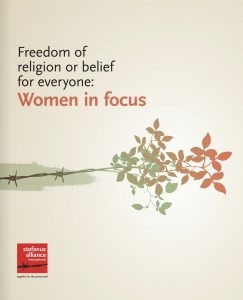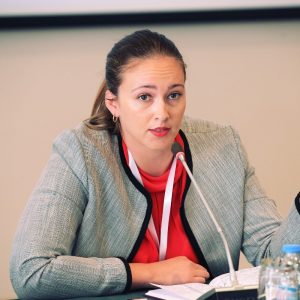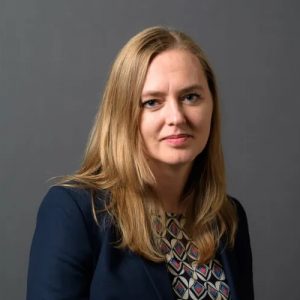A recent report from the Stefanus Alliance argues that men and women experience religious persecution differently and, therefore, religious freedom advocacy needs to have greater gender awareness.
In this interview, Religion & Diplomacy editor Judd Birdsall discusses the report with co-authors Elisa Chavez and Vija Herefoss. Chavez is a human rights advisor and Herefoss is the senior advisor on women and faith at the Stefanus Alliance.
The Stefanus Alliance is an Oslo-based human rights organization with a special focus on freedom of religion or belief (FoRB).
Birdsall: The report contends that most research on FoRB is gender-blind—that is, it does not take gender into account. What would gender-attentive FoRB research and gender-disaggregated FoRB data look like?
Chavez and Herefoss: It is only in the past few years, with an increased awareness of intersectionality in human rights, that we are finally seeing more efforts to explore gendered differences when it comes to violations of freedom of religion or belief (FoRB). For a long time, FoRB research has been gender-blind, often based on the assumption that FoRB violations affect people the same way, regardless of their gender.
One of the basic premises that we constantly bring up in our work is that FoRB violations are always gendered, because the world we live in is gendered. This might seem obvious to many, but a lot of FoRB actors fail to pay attention to this basic fact. Reporting of FoRB violations still tends to focus on issues like imprisonment, killings, restriction of legal rights connected to registration of religious or belief communities, or economic discrimination, all of which are issues that tend to affect men.
Moreover, these violations are often presented in a way that implies that they affect everyone in the same way regardless of their gender, thus making the male experience a default human experience. This is not to say that the men’s FoRB violations are not important, or less important, but it is to say that it is only half of the story.
Gender-attentive FoRB research could start by acknowledging this bias and proceed to make conscious efforts to access and include women’s voices and lived experiences in data collection. This might involve reassessing and possibly changing the main categories and strategies that we use when developing questionnaires or interviews and analyzing the data.
 Birdsall: How do FoRB violations impact women differently?
Birdsall: How do FoRB violations impact women differently?
Chavez and Herefoss: Preliminary research on gender-specific religious persecution shows that men are statistically more likely to be subject to physical violence (like torture or killing), imprisonment, or economic harassment when targeted for violations based on his religious or belief identity. Meanwhile, the same research shows that women are more likely to be subject to sexual violence, incarceration by family or abduction or kidnapping, or forced marriage when targeted for their religious or belief identity. Open Doors International describes this gender-specific religious persecution of men as “focused, severe, and visible,” while for women it is “complex, violent, and hidden.” And although their research focus is limited to religious persecution of Christians, we have through our partnerships and projects learned that these findings resonate largely with a wide range of other religious groups as well.
Perpetrators of any kind of human rights violations, including violations of FoRB, often target individuals based upon their assigned value in society to maximize the damage. It is a universal and global phenomenon that socially constructed ideas of what it means to be a man and what it means to be a woman often translate into how individuals are valued and treated differently by society around them because of their gender. In many contexts around the world, a man’s value is often rooted in his ability to protect or provide for his family, while a woman’s value is often rooted in her abilities of childbearing and representing the honor of her family. In the limited existing research available on gendered FoRB violations, we clearly see how the statistics of “most common” FoRB violations against men and women are directly linked to exactly those values attributed to individuals because of their gender.
Birdsall: In the report you highlight that it is so hard to get data on the FoRB violations faced by women. Why is that?
Chavez and Herefoss: There are a number of reasons for that. For starters, there is the challenge of patriarchal power structures of most religious communities. If an external researcher approaches a religious or belief community inquiring about their experiences of discrimination and persecution, who are the first people they meet? Usually, it would be the individuals representing the community-at-large—namely those in traditional leadership positions—and these would mainly be men. They will share their side of the story, which is no less important than the story of women. But there is a problem when neither the leader nor the researcher realizes that this is just one side of the story, and it is presented as the full one.
Two additional challenges become clear when we review the limited data available on gender-specific religious persecution; namely, who carries out FoRB violations against women and what these violations look like. Firstly, FoRB violations against women are most often committed in the private sphere of society by non-state actors, as opposed to violations against men where the main perpetrators are state actors. Because FoRB violations against women often take place “behind closed doors,” these violations often remain hidden and unreported. Second, with recent data on gender-specific religious persecution, we understand that sexual violence is the most common FoRB violation against women. And we unfortunately know that accounts of sexual violence are underreported because it often happens in hidden spaces and especially because of the stigma around it. Perhaps if we as a society manage to change the fact that shame and stigma around sexual violence tends to be attributed to the survivor rather than the attacker, there can be a change in reporting frequency when this happens.
One more challenge is that there has also historically been a disconnect between advocates of gender equality and advocates of FoRB. This disconnect is commonly based on multiple misconceptions between the two camps of human rights advocates. Then we end up in the unfortunate situation that the group of actors in society who are the experts on gender injustice—and know how to analyze and assess human rights violations with gender glasses on—effectively disregard the role of religion or FoRB in a woman’s life. Similarly, the group of actors in society who are the experts on FoRB violations and the role of religion—and know how to analyze and assess human rights violations with their FoRB glasses on—disregard the role of gender in FoRB violations.
Birdsall: On the topic of this disconnect, the report notes that some view religion as only a hindrance to women’s rights and others view women’s rights as a threat to religion and to FoRB. How can those misconceptions be overcome? What successful initiatives have you seen?

Elisa Chavez
Chavez and Herefoss: These misconceptions are often a result of insufficient communication between actors working for women’s equality and actors working for FoRB. However, human rights are not a menu where you pick and choose some and disregard others; on the contrary, all human rights are indivisible, inalienable, and interdependent. You can never reach the full potential of gender equality without also advocating for the freedom and equality of religious women; and similarly you can never reach FoRB for all, without also advocating for FoRB for women. That is why we often emphasize the importance of strengthening partnerships and collaborations, and especially between secular gender actors and FoRB and religious actors, because the truth is that there is so much overlap in the work they do and who they want to advocate for.
There are many examples of women across the world who show that one can have religious or belief identity and aspire to have equal rights. Organizations like Sisters in Islam and Musawah in Muslim-majority countries are doing trailblazing work in challenging discriminatory legal frameworks within their own religious communities. On the other side of the world, Católicas por el Derecho a Decidir and Catholics for Choice are doing the same within their religious communities on the American continent. ABAAD in Lebanon is one of the few secular gender actors we have come across that is actively reaching out to religious leaders to join forces in preventing sexual- and gender-based violence in their local communities, and their results so far have been groundbreaking and inspiring.
Birdsall: What are some of the contemporary FoRB abuses affecting women that concern you the most?

Vija Herefoss
Chavez and Herefoss: One of them is definitely the issue of sexual violence. Not only because we now know it is the single-most common FoRB violation against women, and also not only because it is so extremely underreported that it is terrifying to think that the little information we have available is just the tip of the iceberg, but also because the nature of this violation is rooted in such a raw and disturbing objectification of a person. It is concerning and disheartening to reflect on how sexual violence is still such a massive issue in most countries in the world today, and how intrinsic it is to the dehumanization of other human beings.
Also, coupling frequency of sexual violence with the notion of women as family or community honor bearers we see a recurring pattern in many conflicts, in which communities in conflict often resort to sexual violence and rape as instruments to weaken the other. In such cases, women’s bodies become battlefields for war and conflicts (often) initiated by men. Again, women’s humanity is so ruthlessly disregarded, as their bodies are used and reduced to a tool or a weapon, in order to punish husbands, sons, extended family, or even the whole religious or belief community on the opposing side.
Birdsall: In some settings, both FoRB and women’s rights are viewed as Western imports that threaten local traditions. How can advocates integrate FoRB promotion and women’s rights promotion without making things more difficult for both causes?
Chavez and Herefoss: In such situations it can be helpful to ask questions about how and by whom these local cultural or religious norms are defined. In most cases the definition rests with those in power, which are usually men from religious majority groups. Unsurprisingly, they tend to prefer to define local traditions in a way that helps them to secure their interests and their claims to power. It is also interesting to pay attention to how the concept of culture is used in these debates. Often culture is described as something static and unchanging. But history shows us the contrary, that even the most conservative and orthodox views and values can change over time.
References and justification of certain traditions to religion, as a divine single source of truth, is often mixed up with other things like culture, economy, or politics. So, unpacking some of these intersecting issues, in cooperation with a range of voices from the same local context, can often give you quite different narratives on which are important local traditions. This will also be key for successful human rights advocacy, because ultimately the change needs to happen by the locals in a given community taking ownership of the advocacy in their own context.
From an international human rights perspective, it is also interesting to go back to the history of the “parent document” of human rights law—the Universal Declaration of Human Rights. As we know, the UN Educational, Scientific, and Cultural Organization (UNESCO) was commissioned to undertake a mapping process of finding universal norms across continents, cultures, and religions, that could become the building blocks of what we know as universal human rights today. So, there was indeed a due process made to map intersecting norms across various cultures and religions or beliefs—not only Western ones. This exploration has been expanded on by the Danish Institute for Human Rights, which has published extensively on how the Global South shaped the international human rights system.
Birdsall: Are there some lessons from your effort to make FoRB more gender-attentive that could be applied to other issues and contexts such as peacebuilding, human trafficking, or development?
Chavez and Herefoss: The journey we have been on in relation to FoRB and gender equality is if anything a testament to the necessity of having an intersectional approach in human rights work. We human beings are complex individuals with multiple intersecting identities, not only based on our gender and our religious/belief identity, but also based on our race, ethnicity, sexual orientation, age, nationality, migration status, disability, and the list goes on. In order to best possibly understand and counter discrimination and human rights violations that affect us, it is therefore important to have an intersectional approach to identify possible multilayered issues.
It is pertinent that you mention peacebuilding, human trafficking, and development. Although we haven’t worked extensively with actors focused on human trafficking, there is an obvious overlap with FoRB violations, and one of our project partners is currently exploring this further when it comes to religious persecution in North Korea. Furthermore, when we see that abduction, kidnapping, sexual violence, and forced marriage is so high up on the list on most frequent FoRB violations against women, it would be valuable to us as FoRB actors to have research and statistics available on how cases of FoRB violations that look like that are also connected to human trafficking. Beyond that, our organization has for a few years now been trying to lift the importance of the intersection of FoRB and the agenda on Women, Peace and Security with other civil society actors working on this in Norway. We have also been investing in a project on how to measure FoRB in development, so stay tuned for updates on this!
Birdsall: What’s next for this project?
Chavez and Herefoss: We estimate we still have a lot to do in the stage we are at currently. It has only been a couple of years since we published our booklet on FoRB and women’s equality in 2021, and because of the pandemic we couldn’t present it or use it for trainings until last year (2022). And what strikes us is that no matter if we present to religious communities at a grassroot level, civil society, government diplomats, or the United Nations, the misconceptions around how FoRB is related to gender equality and vice versa are widespread and complicated. There is still a lot to be done in simple awareness raising and introducing the normative framework of FoRB and gender equality according to international human rights standards.
But for every presentation and training we’ve had so far (which are already about 20 to 30 different ones across 10+ countries even though we just started last year!), we see that there is an immense appetite for talking about this specific intersection of rights. That makes it all worthwhile. It is encouraging to see that as soon as we unpack some of the common misunderstandings between FoRB and gender equality, people from the different activist camps take ownership of the importance of the intersectionality, and they are very hungry to learn more and keep discussing it and integrate the perspective of the other thematic right. It gives us hope that women’s FoRB will not be forgotten moving forward.